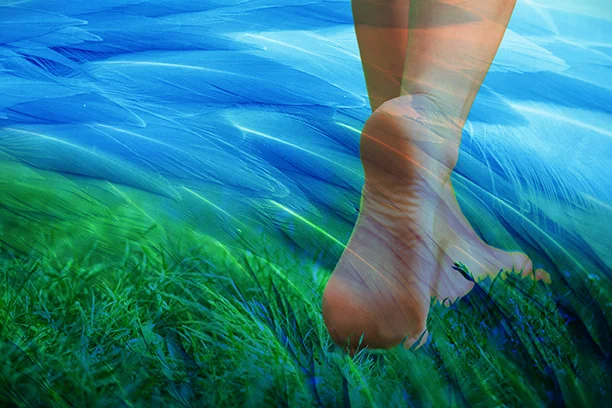
BLUEBIRDS IN THE GRASS, NOT ALAS
My sister Andrea and I are on a cruise in the Caribbean, visiting an island with other passengers. The day is clear and perfect; the sky is a pure azure, as amazing as the sea’s shifting, deeper blues. Andrea and I walk side by side, but she is slightly behind me. I don’t see her as a whole but as billowing white: her sheer cotton blouse moving with the breeze.
We’re at the edge of a vividly green grass lawn, yet commanding my attention is an odd tall tree to the left, some 200 yards away. Or is it a tree? No palm is this tall. The entire tree is dark, as though backlit, and the trunk or shaft rises branchless to a crowning, enormous, nest-like fruition. This outrageous fruit or flower has lapped leaves like an artichoke, a pine cone, a ginger flower (though goblet- or nest-shaped) and from it I see sleek dark forms falling far to the ground.
Andrea and I begin to walk across the silky grass, quite long in some patches, and with my first steps I realize the grass is filled with brilliant baby bluebirds. I gasp, put out my arm to stop Andrea, and simply gawk, overwhelmed. So many of these gorgeous birds at once, stationary! I am thrilled. But they cannot move. They’re nearly the size of independent fledglings, but helpless as nestlings. I am barefoot.
I call out to those ahead, “Stop! Look down—bluebirds!” I think they do. I am focused solely on the ground, the heartbreakingly blue birds, and my careful, slow, barefoot steps. Andrea and I keep moving forward, stunned, happy, looking. 2017
I wake still under the marvel’s thrall, but I sense the wrongness. The birds have fallen, not flown. They are hundreds. They are alive and nearly grown, but unmoving, eyes closed. They are too blue: this plumage is their future. And yet the feeling is elation, a gift of nature. This entire landscape—blue, green, billowing white, soaring dark chalice-tree—is a rare and perfect rightness.
(The title: “Bluebirds in the Grass” was a working title until I remembered Gertrude Stein’s poem beginning “Pigeons on the grass, alas.” I know it only because of James Thurber’s hilariously exasperated essay, “There’s an Owl in My Room.” Thurber and Stein have different views of pigeons. Every time I read the essay, I laugh out loud; it is a primary go-to when I need comic relief. Part-way through writing this dream, I lost a good piece of the file. Gone, vanished, inexplicable—so much so that I spent fruitless time searching my computer, refusing to accept operator stupidity. Finally I gave up, had a glass of wine, made notes of phrases I remembered, and reread Thurber. I laughed out loud. Try it.)
